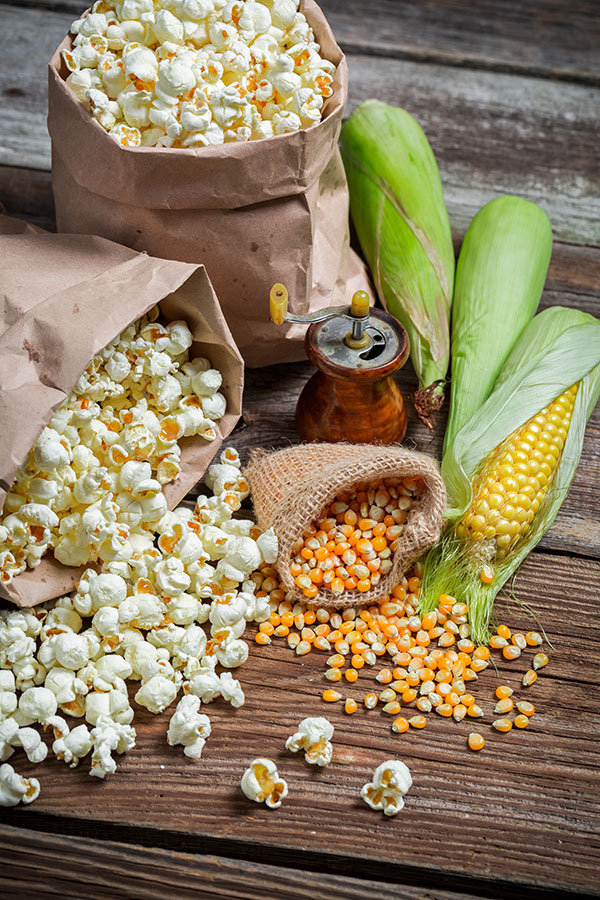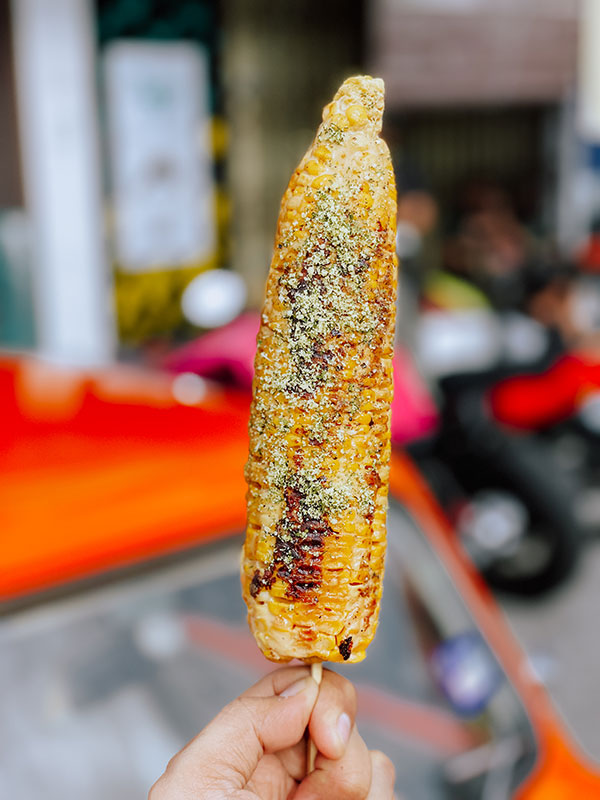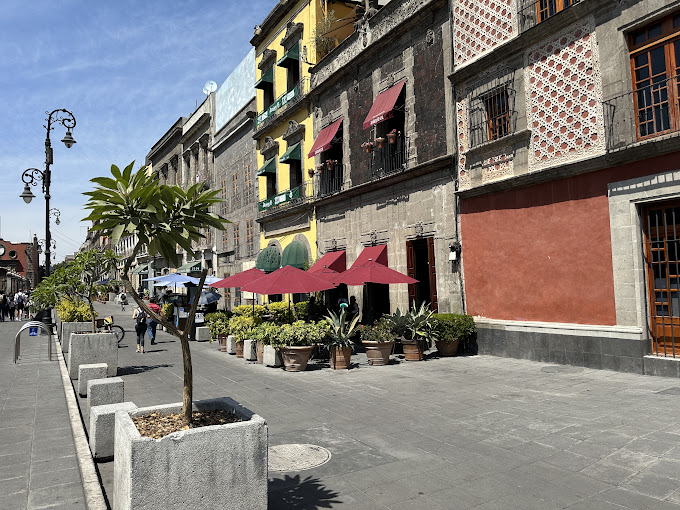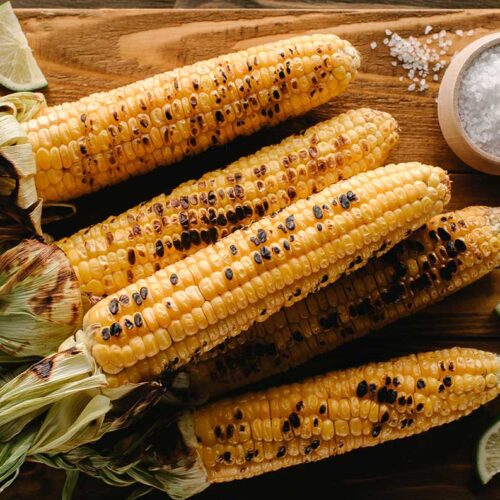In the heart of Mexico City, the air is filled with the enticing aromas of street food. Among the bustling stalls and vibrant plazas, one dish stands out as a crowd favorite—the “Elote Fiesta: Smoky Mexican Grilled Corn on the Cob.” This mouthwatering creation captures the essence of Mexican cuisine, combining the natural sweetness of tender corn with smoky flavors and a burst of tantalizing spices. As the flames dance on the grill, transforming the golden cobs into charred perfection, the anticipation builds for a flavor-packed fiesta.
The story of Elote Fiesta dates back centuries, rooted in the culinary traditions of Mexico’s indigenous cultures. Corn, revered as a sacred crop, plays a starring role in this delightful street food. It is said that the technique of grilling corn on the cob over an open fire was perfected over generations, resulting in the tantalizing smokiness that characterizes Elote Fiesta. Passed down from one generation to the next, this beloved recipe captures the rich history and cultural heritage of Mexico.
As the corn grills, the air fills with an irresistible aroma, drawing food enthusiasts from all corners. The cobs are carefully turned, allowing the flames to kiss the kernels and impart a subtle charred flavor. Then comes the moment of transformation—each cob is slathered with a creamy, tangy sauce made from mayonnaise, sour cream, and a squeeze of lime juice. The final flourish comes in the form of crumbled cotija cheese, a sprinkle of chili powder, and a garnish of fresh cilantro. The result is a harmonious blend of textures and flavors that create a truly unforgettable Elote Fiesta experience.
Table of contents
Inventive Methods for Cooking Corn
Corn is a versatile ingredient that can be prepared in numerous ways, each method unveiling a new dimension of its flavor and texture. One of the most popular ways to enjoy corn is by grilling it. This method imbues the corn with a smoky, charred flavor that’s perfect for outdoor barbecues. Simply soak the corn with the husks on in cold water for about an hour, then place it directly on a preheated grill. Rotate the corn every so often, allowing it to cook evenly. Once grilled, season it with salt, butter, or spices to your liking.



Another delectable method to cook corn is by boiling it. Boiled corn on the cob is a classic preparation that highlights the natural sweetness of the kernels. To boil corn, remove the husks and silk, then place the ears in a pot of boiling water. Cook the corn for about 5 to 7 minutes until the kernels are tender. After boiling, slather the cobs with butter and sprinkle with a touch of salt for a simple, satisfying treat.
Corn can also be transformed into a creamy, comforting dish through a cooking method known as creaming. Creamed corn is typically made by simmering corn kernels in cream, butter, and sugar until a luscious, rich texture is achieved. This dish pairs excellently with a variety of meals and can also be enhanced with additions like bacon, herbs, or cheese. Regardless of your cooking preference, these methods highlight the incredible versatility of corn, allowing you to enjoy this delightful grain in myriad ways.
Effective Methods for Storing Fresh Corn on the Cob
Corn on the cob, with its juicy kernels bursting with sweetness, embodies the essence of summertime. However, ensuring its freshness can be a challenge if not stored properly. Understanding how to preserve corn on the cob properly can significantly enhance its shelf life and maintain its vibrant flavor.
Begin the preservation process immediately after purchase. Corn on the cob starts to lose its flavor soon after it’s picked due to the conversion of sugar into starch. Therefore, if you’re not planning to cook the corn right away, refrigeration is crucial. Store the corn in the vegetable crisper of your fridge with the husks still on. The husks provide natural protection and help retain the corn’s moisture and freshness. The optimal temperature for storage is between 35 to 40 degrees Fahrenheit, which slows down the conversion process.
Additionally, for longer-term storage, consider freezing your corn on the cob. Prior to freezing, blanch the corn by plunging it into boiling water for a few minutes and then immediately cooling it in ice water. This process not only stops the conversion of sugar to starch but also preserves the bright yellow color of the kernels. Once cooled, wrap the cobs individually in plastic wrap and then store them in airtight freezer bags. This method can effectively maintain the quality of corn on the cob for up to a year.
The Evolutionary Journey of Corn Through History
Corn, known scientifically as Zea mays, has a rich and intricate history. Its origin traces back to a wild grass called teosinte, native to Mexico over 7,000 years ago. Farmers in the region cultivated and selectively bred this crop over centuries, progressively changing its genetic makeup. This ultimately resulted in the familiar ear of corn we see today, bearing little resemblance to its wild ancestor. The process demonstrates one of the earliest and most significant examples of the influence of human agriculture on plant development.
From its roots in Mexico, corn spread throughout the Americas due to trade and migration. The indigenous peoples of North and South America recognized its nutritional value and adapted it into their diets. Notably, the native peoples of North America taught European settlers how to grow and use corn, leading to its incorporation into European diets. Over time, the settlers began growing corn more extensively than any other crop, owing to its versatility and high yield.
The twentieth century witnessed a new chapter in corn’s history with the advent of modern farming techniques and genetic modification. Scientists developed hybrids to increase crop yields and resistance to pests. Nowadays, corn has a multifaceted role, serving not only as a staple food but also as a source of biofuel, animal feed, and raw material for industrial products. This versatile grain’s journey, from a wild grass in ancient Mexico to a globally significant crop, illustrates the profound impact of human ingenuity on the natural world.
The Vibrant Metropolis: Unveiling the Layers of Mexico City
Mexico City, a sprawling metropolis nestled in the Valley of Mexico, thrives as the capital of Mexico. It stands as one of the most populous cities globally, brimming with a diverse populace and a rich tapestry of cultures. The city’s dynamic history, marked by pre-Columbian civilizations, Spanish colonial rule, and modern progression, greatly influences its unique character today.

Dive into Mexico City’s vibrant culture, and you will discover an impressive range of artistic and culinary treasures. It boasts over 150 museums, art galleries, and performance venues that pay homage to its cultural heritage and foster contemporary creativity. Meanwhile, the city’s culinary scene excites the palate with everything from traditional street food like tacos and tamales to high-end dining experiences, showcasing Mexico’s culinary diversity.
Beyond its cultural allure, Mexico City stands as a significant economic powerhouse. It contributes more than a fifth of the country’s GDP, underlining its crucial role in Mexico’s economy. The city hosts numerous multinational corporations, significant financial institutions, and a burgeoning tech industry. Amid its buzzing streets, ancient ruins, colonial architecture, and towering skyscrapers, Mexico City exudes an indomitable spirit, offering a glimpse into Mexico’s past and its ambitious strides toward the future.
Mexico City: Tracing its Historical Tapestry
Unraveling the historical threads of Mexico City reveals an engaging narrative that spans millennia. Its story commences with the ancient Aztecs who founded the city of Tenochtitlan on an island in Lake Texcoco in 1325. As the Aztec empire flourished, so did the city, becoming one of the most populous and sophisticated centers in the pre-Columbian era.
The city’s narrative took a drastic turn in 1521 when Spanish Conquistador Hernán Cortés and his men seized Tenochtitlan. They razed the Aztec city to the ground and, on its ruins, established what would become Mexico City, the capital of New Spain. This marked the beginning of a three-century-long colonial period that left an indelible imprint on the city’s architecture, culture, and societal fabric.
In the 19th century, Mexico City transitioned from a colonial capital to a sovereign one after Mexico gained independence from Spain in 1821. Throughout the tumultuous years of revolution and political shifts in the 20th century, Mexico City expanded and evolved. Today, it stands as a sprawling metropolis that pays homage to its rich past while continually reinventing itself, making it one of the most fascinating cities in the world.
Mexico City: A Haven for Global Travelers
Mexico City continues to enthrall global tourists with its charismatic blend of history, culture, and urban sophistication. Its historic center, a UNESCO World Heritage site, offers an intriguing walk through time. The Zócalo, or Plaza de la Constitución, is a focal point, surrounded by significant landmarks such as the Metropolitan Cathedral, the National Palace, and the ancient Aztec temple complex, Templo Mayor.
Beyond its historic core, Mexico City invites exploration of its diverse neighborhoods. The bohemian spirit of Coyoacán, the artsy vibe of San Ángel, and the upscale allure of Polanco each contribute to the city’s vibrant character. The city also houses renowned museums such as the Frida Kahlo Museum, the Museum of Anthropology, and the Palace of Fine Arts, which host a wealth of artistic and historical treasures.
However, Mexico City’s allure extends beyond its tangible attractions. The city exudes an infectious energy, found in its bustling markets, vibrant festivals, and the warmth of its people. Whether you’re dining at a street-side taco stand, admiring murals of Diego Rivera, or exploring the lush Chapultepec Park, you are experiencing the true essence of Mexico City, making it a truly captivating destination for any traveler.
Mexico City: A Melting Pot of Culinary Delights
Mexico City is a gastronomic paradise that tantalizes the taste buds with an array of flavors. The city’s culinary scene is steeped in tradition, with ancestral recipes passed down generations, alongside innovative creations inspired by international trends. Street food stalls offer a vibrant introduction to the city’s food culture, serving dishes like tacos al pastor, quesadillas, and tamales, each bursting with distinctive flavors.
Yet, Mexico City’s culinary offerings extend beyond street food. The city boasts an impressive number of gourmet restaurants, where acclaimed chefs present traditional Mexican cuisine with an avant-garde twist. Restaurants such as Pujol, Quintonil, and Sud 777 have earned international acclaim for their culinary creativity and commitment to showcasing local ingredients.
Moreover, Mexico City celebrates its culinary heritage through numerous food festivals and markets. Markets like Mercado de San Juan and La Merced offer a feast for the senses, with their colorful produce, fragrant spices, and local delicacies. From mouthwatering street food to high-end dining experiences, the cuisine of Mexico
– Featured Restaraunt –
Restaurante Catedral
Donceles 95, Centro Histórico de la Cdad. de México, Centro, Cuauhtémoc, 06020 Ciudad de México, CDMX, Mexico
Telephone: +52 55 5518 5232

Located behind the Metropolitan Cathedral and a few steps from the archaeological remains of the Templo Mayor and the National Palace in the Plaza de la Constitución, the most emblematic tourist and business area in the country, the Hotel Catedral brings together due to its location, quality, and cleanliness of its facilities, for its delicious food and for the friendliness of its staff, everything necessary to become the ideal option during your visit to Mexico City.
Mastering the Art of Grilling Corn on the Cob
Grilling corn on the cob invites a transformation in this humble vegetable, enhancing its natural sweetness and adding a smoky flavor that is hard to resist. The process begins with selecting fresh, plump corn on the cob with vibrant green husks. For added flavor, keep the husks on while grilling. Before grilling, soak the corn in cold water for about an hour. This step helps the corn steam on the grill and prevents the husks from burning too quickly.
Preheat your grill to medium heat for optimal results. Place the soaked corn on the grill, arranging them in such a way that the husks are not directly over the flame. Close the grill lid, creating an oven-like environment that allows the corn to cook evenly. Rotate the corn every 5 minutes using tongs to ensure all sides get beautifully charred. The total cooking time should be about 15 to 20 minutes.
When the corn is nicely charred and the kernels are tender, remove them from the grill. Allow the corn to cool for a few minutes, then carefully peel back the husks and remove the silk. At this point, the corn is like a blank canvas, ready to absorb a myriad of flavors. You can simply brush it with melted butter and sprinkle it with salt, or experiment with different toppings like chili powder, lime juice, or a sprinkle of fresh herbs. With these simple steps, you can elevate basic corn on the cob into a grilled masterpiece.
Essential Ingredients and Tools for Grilling Corn on the Cob
Embarking on the culinary adventure of grilling corn on the cob requires just a handful of key ingredients and tools. Fresh, plump ears of corn serve as the star of the dish, while a grill (charcoal or gas) acts as the primary cooking tool. Water for soaking the corn, salt for seasoning, and butter for slathering are essential to enhance the corn’s natural flavor. Optional additions include herbs, spices, and other condiments to give your grilled corn an extra kick. With these basic elements on hand, you’re ready to transform humble corn into a smoky, savory delight.
Equipment
- Grill (charcoal or gas)
- Mixing Bowl
- Brush or basting brush
- Tongs
- Small bowl or dish
- Serving platter
Ingredients
- 4 ears of corn husks removed
- ¼ cup mayonnaise
- ¼ cup sour cream
- ¼ cup crumbled cotija cheese or feta cheese as a substitute
- 1 tablespoon lime juice
- 1 teaspoon chili powder
- ½ teaspoon smoked paprika
- ¼ teaspoon cayenne pepper optional, for added heat
- salt to taste
- black pepper to taste
- cilantro chopped (for garnish)
- lime wedges (for serving)
Step-by-Step Guide to Grilling Corn on the Cob
Grilling corn on the cob elevates the humble vegetable to new heights, imbuing it with a smoky depth and tantalizing sweetness. The process starts with selecting fresh ears of corn and soaking them in water. Following this, you’ll engage your grill, strategically placing the corn to avoid direct flame yet allowing it to cook thoroughly. The final steps involve careful turning for an even char and a liberal application of butter or other chosen condiments. In the following guide, we will walk you through these steps in detail, ensuring you can confidently create delicious grilled corn on the cob at home.
Time needed: 1 hour and 25 minutes
Grilling Directions
- Soak the Corn
Before grilling, soak the corn in cold water for about an hour.
- Preheat the Grill
Preheat the grill to medium-high heat.
- Mix the Sauce
In a mixing bowl, combine ¼ cup mayonnaise, ¼ cup sour cream, ¼ cup crumbled cotija cheese, 1 tablespoon lime juice, 1 teaspoon chili powder, ½ teaspoon smoked paprika, ¼ teaspoon cayenne pepper (if using), salt, and black pepper. Mix well to create a creamy sauce. Set aside.
- Grill the Corn
Place the 4 ears of corn directly on the grill grates. Grill for about 10-15 minutes, turning occasionally, until the corn kernels are tender and slightly charred. Remove from the grill and let cool for a few minutes.
- Brush with the Sauce
Using a brush or basting brush, generously slather the grilled corn with the prepared sauce, ensuring it is evenly coated.
- Sprinkle the Cheese
Sprinkle additional cotija cheese, chili powder, and chopped cilantro over the corn.
- Arrange and Garnish
Arrange the corn on a serving platter and garnish with lime wedges.
- Serve the Grilled Corn on the Cob
Serve immediately while still warm. Squeeze lime juice over the corn just before eating for an extra burst of freshness.
Enjoy the splendid blend of flavors that make grilled corn on the cob a timeless summer classic.
If you liked this dish please Rate This Recipe and leave a comment.
Smoky Mexican Grilled Corn on the Cob
Please Rate this Recipe
Equipment
- Grill (charcoal or gas)
- Brush or basting brush
- Tongs
- Small bowl or dish
- Serving platter
Ingredients
- 4 ears corn husks removed
- ¼ cup mayonnaise
- ¼ cup sour cream
- ¼ cup crumbled cotija cheese or feta cheese as a substitute
- 1 tablespoon lime juice
- 1 teaspoon chili powder
- ½ teaspoon smoked paprika
- ¼ teaspoon cayenne pepper optional, for added heat
- salt to taste
- black pepper to taste
- cilantro chopped (for garnish)
- lime wedges (for serving)
Instructions
- Before grilling, soak the corn in cold water for about an hour.
- Preheat the grill to medium-high heat.
- In a mixing bowl, combine ¼ cup mayonnaise, ¼ cup sour cream, ¼ cup crumbled cotija cheese, 1 tablespoon lime juice, 1 teaspoon chili powder, ½ teaspoon smoked paprika, ¼ teaspoon cayenne pepper (if using), salt, and black pepper. Mix well to create a creamy sauce. Set aside.
- Place the 4 ears corn directly on the grill grates. Grill for about 10-15 minutes, turning occasionally, until the corn kernels are tender and slightly charred. Remove from the grill and let cool for a few minutes.
- Using a brush or basting brush, generously slather the grilled corn with the prepared sauce, ensuring it is evenly coated.
- Sprinkle additional cotija cheese, chili powder, and chopped cilantro over the corn.
- Arrange the corn on a serving platter and garnish with lime wedges.
- Serve immediately while still warm. Squeeze lime juice over the corn just before eating for an extra burst of freshness.
Notes
- You can boil the corn for 5 minutes before grilling to ensure it’s tender, but grilling directly without boiling can enhance the smoky flavor.
- If cotija cheese is not available, feta cheese makes a suitable substitute.
- Adjust the amount of chili powder and cayenne pepper according to your desired level of spiciness.
- For a variation, you can sprinkle the corn with Tajin seasoning or hot sauce for an added kick.
- This dish pairs well with grilled meats, tacos, or as a standalone appetizer. Enjoy the smoky, cheesy, and tangy flavors!
Nutrition
Complementary Dishes to Pair with Grilled Corn on the Cob
Grilled corn on the cob, with its charred sweetness and smoky flavor, is undeniably a star on its own. However, its versatility allows it to shine even brighter when accompanied by other well-suited dishes. From sizzling barbecued meats to fresh, vibrant salads, certain recipes inherently complement the robust character of grilled corn. Let’s explore an array of dishes that not only match but enhance the delectable taste of grilled corn, creating a feast for the senses.
After going through these recipes, you’re now equipped with a variety of complementary dishes that can elevate your grilled corn experience. Whether you opt for succulent grilled meats, light, and refreshing salads, or flavorful beans, these pairings highlight the corn’s sweetness while adding diverse textures and flavors to your plate. Next time you’re planning a cookout or simply craving grilled corn on the cob, remember these pairings for a well-rounded, satisfying meal. Remember, the beauty of cooking lies in experimentation, so feel free to try new combinations and find your unique pairings. Happy grilling!
Photo Credits:
- By Taste The World Cookbook – Copyright 2022 All rights reserved.
- By Restaurante Catedral – By https://www.hotelcatedral.com/



